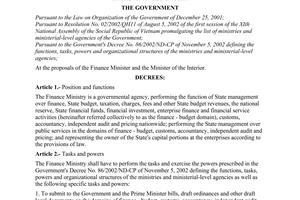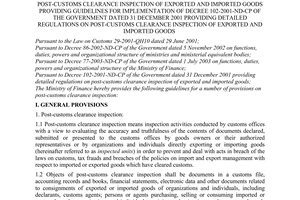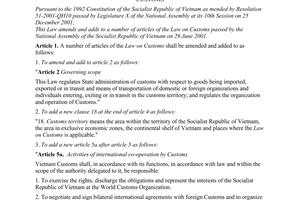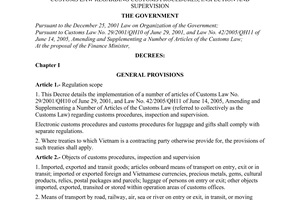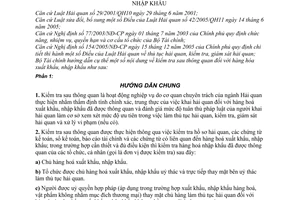Circular no. 114/2005/TT-BTC of December 15, 2005 guiding the post-customs clearance inspection of exports and imports đã được thay thế bởi Circular No. 79/2009/TT-BTC of April 20, 2009, guiding customs procedures; customs inspection and supervision; import duty, export duty and tax administration applicable to imports and exports. và được áp dụng kể từ ngày 04/06/2009.
Nội dung toàn văn Circular no. 114/2005/TT-BTC of December 15, 2005 guiding the post-customs clearance inspection of exports and imports
|
THE
MINISTRY OF FINANCE |
SOCIALIST
REPUBLIC OF VIET NAM |
|
No. 114/2005/TT-BTC |
Hanoi, December 15, 2005 |
CIRCULAR
GUIDING THE POST-CUSTOMS CLEARANCE INSPECTION OF EXPORTS AND IMPORTS
Pursuant to Customs Law No.
29/2001/QH10 of June 29, 2001;
Pursuant to Law No. 42/2005/QH11 of June 14, 2005, amending and supplementing a
number of articles of the Customs Law;
Pursuant to the Government’s Decree No. 77/2003/ND-CP of July 1, 2003, defining
the functions, tasks, powers and organizational structure of the Finance
Ministry;
Pursuant to the Government’s Decree No. 154/2005/ND-CP of December 15, 2005
detailing the implementation of a number of articles of the Customs Law
regarding the customs procedures, inspection and supervision;
The Finance Ministry hereby guides in detail a number of contents on
post-customs clearance inspection of exports and imports as follows:
Part A
GENERAL GUIDANCE
1. Post customs clearance inspection means a professional activity carried out by specialized customs agencies in order to evaluate the accuracy and truthfulness of customs declarations on exports and imports already cleared from customs procedures and to assess the observance of law by customs declarers for use as bases for consideration of the priority levels in carrying out customs procedures, inspection and supervision and handling of violations (if any).
2. Post customs clearance inspection shall be conducted through the inspection of customs dossiers, accounting vouchers, accounting books, financial statements and documents related to exports and imports; in cases where it is necessary or conditions permit, the inspection shall be conducted on imports, which have been already cleared from customs procedures, of the following organizations and individuals (called the inspected units):
a. Owners of exports and imports.
b. Organizations entrusted by export and import goods owners to directly carry out the customs procedures.
c. Lawfully authorized persons (applicable to the export and import of goods, articles not for commercial purposes) who carry out, on behalf of goods owners, the customs procedures for goods and/or articles exported or imported not for commercial purposes.
d. Customs procedures agents.
e. Enterprises providing postal services, international express mail services, which carry out, on behalf of goods owners, the customs procedures for goods exported or imported via postal services or international express mail services.
3. The post-customs clearance inspection shall be carried out on the following principles:
The customs dossiers of exports and imports already cleared from customs procedures shall all be inspected after the customs clearance according to the principles of customs inspection defined in Clause 1a, Article 15 of the Law Amending and Supplementing a Number of Article of the Customs Law and in accordance with provisions of law; information confidentiality; objectiveness, accuracy and non-obstruction to normal production and business activities of the inspected units.
4. Signs of violations of customs law specified in Clause 1, Article 64 of the Government’s Decree No. 154/2005/ND-CP of December 15, 2005 (hereinafter called Decree No. 154/2005/ND-CP) include:
a. Unlawful and invalid vouchers in the customs dossiers under the regulations on forms, inscribed contents, temporal order (disparity, incompatibility, inconsistency, irrationality among vouchers in the customs dossiers related to information on goods name, quantity, weight; volume; label; tax identification number, tax rate; ingredient and composition; utility; packing specifications and other properties of goods), or signs of forgery of vouchers.
b. Irrational import tax calculation prices:
- Being much lower or much higher than the sale prices of such goods on the domestic market after subtracting tax, reasonable expenses and profits; the import tax calculation prices of identical goods or similar goods which are imported by other units simultaneously, from the same market or by the same delivery mode;
- Untruthful declaration of additions to, or subtractions form, transaction value, the special relationship between the buyer and the seller; mode and time of actual payment at variance with customs declaration;
- Irrationality in declaration of transportation mode, means of transport, transport distance, transport route, freight and insurance costs, which are related to the determination of customs value.
c. Fraudulence in enjoyment of tax preferences or trade frauds such as using raw materials and auxiliary materials for improper purposes, fraudulence in raw materials, auxiliary materials consumption norms, for processed goods, goods imported for production of export goods; fraudulence for enjoyment of tax exemption, reduction or refund according to the provisions of tax law or exported, imported goods; importing goods which violate regulations on intellectual property and regulations on goods origin.
d. Exports and imports subject to specialized management, but for which the permits are invalid or the conditions for export or import are not fully met; deeds of assessment, analysis, classification of exports and imports are not true to the actual conditions of goods.
5. Time limit for inspection at offices of inspected units
a. Before conducting inspections under plans, customs offices must notify the inspection decisions to the to be-inspected units at least 5 working days in advance. Where customs offices have grounds to determine that units show signs of destroying dossiers, documents, the inspection shall be carried out immediately after the announcement of inspection decisions without advance notices.
B. The working days at offices of inspected units specified in Clause 1 and 2 Article 68 of Decree No. 154/2005/ND-CP shall be the days the customs offices actually conduct the inspections at such units, in case of interrupted inspections, the reasons therefor must be clearly stated in the minutes.
6. Responsibilities of customs offices at different levels for post customs clearance inspection.
a. Post customs clearance inspection rests with the General Department of Customs and provincial/municipal Department of Customs.
b. The General Director of Customs shall manage, direct, guide and inspect units in the entire customs service on post customs clearance inspection, decision on post clearance inspection according to the guidance in this Circular.
The Post Customs Clearance Inspection Department of the General Department of Customs shall act as a specialized body assisting the General Director of Customs in managing, directing, guiding and inspecting the post customs clearance inspection according to regulations.
c. Directors of provincial/municipal Departments of Customs shall organize the post customs clearance inspections in localities under their respective management as specified in the Appendix issued together with this Circular.
The Post Customs Clearance Inspection Sections of provincial/municipal Departments of Customs shall act as specialized units assisting directors of Department of Customs in performing the post customs clearance inspection.
d. Officials and employees specialized in performing the post customs clearance inspection must, apart from the general criteria of the customs employees, have necessary knowledge and skills and be trained in laws on tax, accounting, audit and laws on inspection and examination. The General Director of Customs shall have to specify the criteria of, organize trainings for, and arrange officials to perform the post customs clearance inspection.
7. Competence to decide on post customs clearance inspections.
a. Directors of provincial/municipal Departments of Customs shall decide on inspections at inspected units in areas under their respective management (places of tax identification number registration). Where units subject to post customs clearance inspection are located outside the management areas but have already carried out the customs procedures in the management areas, if signs of violation are detected, the inspection shall be conducted in the following order:
- Inspecting relevant dossiers and documents of the inspected units at the headquarters of customs bodies;
- If it is necessary to conduct inspections directly at the offices of the inspected units, reporting such to the General Department of Customs and notifying the Department of Customs managing the areas thereof.
b. The General Director of Customs shall decide on post customs clearance inspection in cases where the inspection contents are complicated or the inspection scope covers many provinces and/or centrally-run cities.
The General Director of Customs may authorize the director of the Post Customs Clearance Inspection Department to decide on post customs clearance inspection.
Part B
SPECIFIC GUIDANCE
I. POST CUSTOMS CLEARANCE INSPECTION FORMS AND METHODS
The post customs clearance inspection of customs dossiers of exports and imports already cleared from customs procedures shall be conducted in the following forms and by the following methods:
1. Inspection at headquarters of customs offices by mode of comparison between the contents declared in the customs dossiers and the professional customs information and relevant provisions of law.
2. Inspection at offices of to be-inspected units by mode of comparison between the accounting books, accounting vouchers, financial statements as well as other vouchers relating to exports and imports and the contents in the customs declarations. In case where it is necessary and the conditions are fully met, the actual inspection of goods already cleared form customs procedures shall be conducted.
II. POST CUSTOMS CLEARANCE INSPECTION ORDER AND CONTENT
1. Inspection at headquarters of customs offices
a. Inspection of customs dossiers:
- Inspection of the completeness, legality and validity of vouchers in the customs dossiers against the contents in the customs declarations;
- Inspection of tax declaration, calculation and payment through determination of tax calculation bases, including dutiable value, tax rate, quantity of exports or imports;
- Inspection of the conditions related to enjoyment of tax preferences such as tax exemption, reduction, refund (if any), adjusted tax amounts and other collections;
- Inspection of the observance of regulations on polices on management of exports and imports, intellectual property rights and other regulations related to customs procedures.
b. Upon completion of the inspection of customs dossiers, the post customs clearance inspections shall have to conclude on the inspection results;
- For complete and clear customs dossiers without violations, to certify the inspection results;
- For customs dossiers which are unclear, incomplete, or show signs of law violations, the post customs clearance inspectors shall clearly inscribe such on the inspection result cards and report to their direct superior thereon.
c. For unclear or incomplete customs dossiers, the customs offices shall have to make verifications at relevant agencies, organizations or individuals and notify such to the to be-inspected units for explanation on, or addition of necessary information and/or documents.
- Where the verification or explanation, addition of complete information and/or documents prove that the customs declarations is truthful, such customs dossiers shall be certified according to regulations. If the verification or explanation cannot prove that the customs declaration is truthful, the units shall be requested to make additional declarations. Within 60 days after the registration of customs declarations, if the inspected unit conduct the inspection by themselves of the goods lot already cleared from customs procedures in term of the accuracy, honestly of the customs declarations, the tax calculation and payment and voluntarily inform the customs offices and pay by themselves the outstanding tax amounts, fines for delayed payment, they shall be exempt from other tax-related sanctioning forms.
- Where within 60 days after registration of the customs declarations the inspected units cannot detect things by themselves and redress the consequences, or where the results of verifications, inspections, comparisons by customs office help identify violations, the inspectors must make written inspection conclusions and handle results according to provisions of Point 3, Section II, Part B of this Circular.
- Where units do not come or have come to the customs offices but cannot explain and the additional dossiers, documents do not constitute adequate grounds to prove that the customs declaration is truthful, the customs offices shall base themselves on the information and/or documents to make conclusions or conduct inspections at the offices of the inspected units.
2. Inspection at offices of inspected units
a. When conducting inspections at offices of inspected units, inspectors shall:
- Announce the post customs clearance inspection decisions;
- Inspect the accounting vouchers, accounting books and financial statements related to exports and imports already cleared from customs procedures.
- Check commercial data, including the following principal vouchers: goods sale and purchase contracts; transport documents, insurance documents; international payment documents and other vouchers, documents related to exports and imports already cleared from customs procedures.
- In cases where it is necessary to clarify the contents of the customs declarations, post customs clearance inspectors shall conduct verifications at relevant agencies, organizations or individuals.
b. In case of necessity:
- Inspect production chains, machinery and equipment related to production and processing of exports and imports;
- Conduct actual inspection of imports or products of the processing, production from imports being held in storehouses of the units. The actual inspection of goods shall be carried out when conditions permit, if the goods do not lose their basic properties as compared with those at the time of customs clearance, are being kept by customs offices, inspected units or other agencies, organizations or individuals.
c. Upon completion of inspection, heads of inspection teams shall make written inspection conclusions. A written inspection conclusion must be signed by the inspection team head and lawful representative of the inspected unit; where the representative of the inspected unit refuses to sign the written inspection conclusion, the inspection team head must clearly inscribe the former’s reasons for refusal. The written inspection conclusions must be addressed to inspection deciders for use as a basis to handle violations (if any) according to the provisions of Point 3, Section II, Part B of this Circular.
3. Handling of inspection results
a. In case of retrospective collection of taxes and other collections, the person who decide on the post customs clearance inspection shall handle such case according to competence or propose in writing the competent persons to issue decisions on retrospective collection according to provisions of tax law. The retrospectively collected amounts shall be remitted into custody accounts of provincial/municipal Department of Customs that have decided or the inspections. In cases where the General Director of Customs has decided on the inspections, the retrospectively collected amounts shall be remitted into the custody accounts of the Departments of Customs of the provinces or cities where the inspected units are located.
b. In case of refund of taxes and/or other collections, the persons who have decided on the post customs clearance inspection shall handle such case or notify such in writing and transfer the case files to the provincial, inter-provincial or municipal Department of Customs that have carried out the customs procedures for the exports or imports lots for consideration and refund according to the provisions of tax law.
c. In cases where the handling of administrative violations falls under the handling competence of the customs offices, the persons who decide on the post customs clearance inspection shall handle them according to their competence or propose the competent authorities to handle them according to the provision of law. In case where the administrative violations do not fall under the handling competence of the customs office, the persons who decide on the post customs clearance inspection shall forward the case files to competent bodies for handling according to provisions of law.
d. In case where violation acts must be examined for penal liability, the provisions of the criminal procedure law shall apply.
4. Monitoring the handling of inspection results
The post customs clearance inspection deciders have the responsibilities:
a. To direct the monitoring and urging of inspected units to abide by the handling decisions according to the inspection results. To apply coercive measures according to provisions of tax law and other relevant laws. The time limit for the retrospective collection of tax, retrospective refund of tax, fine and other handling forms shall comply with the provisions of tax law and other relevant provisions of law.
b. To notify concerned provincial, inter-provincial, municipal Department of Customs, border gate Customs Sub-Departments of the conclusions of the inspection teams, measures of handling the law violations (if any) by inspected units.
c. To update information on inspection results to the database according to procedures guided by the General Director of Customs.
Part C
COMPLAINTS, DENUCIATIONS, INITIATION OF LAWSUITS; COMMEDATION, HANDLING OF VIOLATIONS
1. Complaints, denunciations and initiation of lawsuits
The complaints, denunciations, initiation of lawsuits related to post customs clearance inspection shall comply with the provisions of law.
2. Commendation, handling of violations
a. Customs employees who commit acts of violating the law provisions on post customs clearance inspection shall, depending on the nature and seriousness of their violations, be disciplined or examined for penal liability; if causing damage to the inspected units, they must pay compensations therefor according to provisions of law.
Other organizations and individuals that commit acts of violating the provisions of law on post customs clearance inspection shall be administratively sanctioned or examined for penal liability according to provisions of law, depending on the nature and seriousness of their violations.
c. Customs offices and customs officers that record achievements in post customs clearance inspection; other agencies, organizations and individuals that record achievements in coordination or implementation of the post customs clearance inspection shall be commended and/or rewarded according to provisions of law.
Part D
IMPLEMENTATION ORGANIZATION
1. General Director of Customs shall have to promulgate the procedures for post customs clearance inspection of exports and imports and guide provincial, inter-provincial and municipal Department of Customs for the uniform implementation thereof.
2. This Circular takes effect 15 days after its publication in Official Gazette. To annul the Finance Ministry’s Circular NO. 96/2003/TT-BTC of October 10, 2003, guiding the Government’s Decree No. 102/2001/ND-CP of December 31, 2001 providing for the post customs clearance inspection of exports and imports.
|
|
FOR THE
FINANCE MINISTER |
APPENDIX
LIST OF GEOGRAPHICAL AREAS ASSIGNED TO
PROVINCIAL/MUNICIPAL CUSTOMS DEPARTMENTS FOR POST CUSTOMS CLEARANCE INSPECTION
(Issued together with the Finance Ministry’s Circular No. 114/2005/TT-BTC of
December 15, 2005)
|
Ordinal Number |
Provincial, inter-provincial, municipal Customs Department |
Provinces, cities assigned for post customs clearance inspection |
|
1 |
An Giang province’s Customs Department |
An Giang Province |
|
2 |
Ba Ria – Vung Tau province’s Customs Department |
Ba Ria Vung Tau Province |
|
3 |
Binh Duong province’s Customs Department |
Binh Duong Province |
|
4 |
Binh Dinh province’s Customs Department |
Binh Dinh and Phu Yen Provinces |
|
5 |
Binh Phuoc province’s Customs Department |
Binh Phuoc Province |
|
6 |
Cao Bang province’s Customs Department |
Cao Bang, Thai Nguyen and Bac Can Provinces |
|
7 |
Ca Mau province’s Customs Department |
Ca Mau and Bac Lieu Provinces |
|
8 |
Can Tho City’s Customs Department |
Can Tho city and the provinces of Hau Giang, Vinh Long, Soc Trang and Tra Vinh |
|
9 |
Da Nang City’s Customs Department |
Da Nang City |
|
10 |
Dac Lac province’s Customs Department |
Dac Lac, Dac Nong and Lam Dong Provinces |
|
11 |
Dong Nai province’s Customs Department |
Dong Nai and Binh Thuan Provinces |
|
12 |
Dong Thap province’s Customs Department |
Dong Thap Province |
|
13 |
Gia Lai province’s Customs Department |
Gia Lai and Kon Tum Provinces |
|
14 |
Ha Giang province’s Customs Department |
Ha Giang and Tuyen Quang Provinces |
|
15 |
Hanoi city’s Customs Department |
Hanoi, the provinces of Ha Tay, Phu Tho, Vinh PHuc, Bac Ninh and Hoa Binh |
|
16 |
Ha Tinh province’s Customs Department |
Ha Tinh Province |
|
17 |
Hai Phong City’s Customs Department |
Hai Phong city and provinces of Thai Binh, Hung Yen and Hai Duong |
|
18 |
Khanh Hoa province’s Customs Department |
Khanh Hoa and Ninh Thuan Provinces |
|
19 |
Kien Giang province’s Customs Department |
Kien Giang Province |
|
20 |
Bien Bien province’s Customs Department |
Dien Bien, Lai Chau and Son La Provinces |
|
21 |
Lang Son province’s Customs Department |
Lang Son and Bac Giang Provinces |
|
22 |
Lao Cai province’s Customs Department |
Lao Cai and Yen Bai Provinces |
|
23 |
Long An province’s Customs Department |
Long An, Ben Tre and Tien Giang Provinces |
|
24 |
Nghe An province’s Customs Department |
Nghe An Province |
|
25 |
Quang Binh province’s Customs Department |
Quang Binh Province |
|
26 |
Quang Nam province’s Customs Department |
Quang Nam Province |
|
27 |
Quang Ngai province’s Customs Department |
Quang Ngai Province |
|
28 |
Quang Ninh province’s Customs Department |
Quang Ninh Province |
|
29 |
Quang Tri province’s Customs Department |
Quang Tri Province |
|
30 |
Thanh Hoa province’s Customs Department |
Thanh Hoa, Ha Nam, Nam Dinh and Ninh Binh Provinces |
|
31 |
Thua Thien Hue province’s Customs Department |
Thua Thien Hue Province |
|
32 |
Tay Ninh province’s Customs Department |
Tay Ninh Province |
|
33 |
Ho Chi Minh City’s Customs Department |
Ho Chi Minh City |

